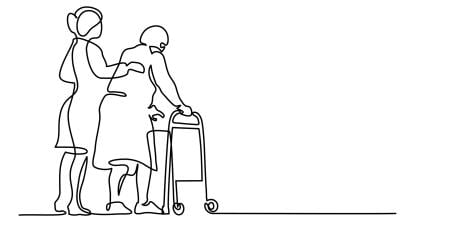Case
Gerard was a registered nurse in the intensive care unit (ICU) at a large city hospital. Mrs. Smith was admitted to his unit with chest pain and shortness of breath. At 80, Mrs. Smith had no significant past medical history, apart from mild hypertension and arthritis. Upon admission, she was hypoxic and subsequently received supplemental oxygen. Otherwise her vital signs were stable. On physical exam, Mrs. Smith was noted to have bilateral rales, and the presence of an S3 was noted upon cardiac auscultation. Pertinent laboratory results included cardiac biomarkers (troponin, CK and CK-MB), which were elevated; a portable CXR revealed pulmonary edema; and a 12-Lead ECG demonstrated normal sinus rhythm with T wave inversions noted on the anterior precordial leads. Mrs. Smith was admitted for a non-ST elevation myocardial infarction, and started on standard medical therapy, which included a heparin drip.
Soon after admission, Mrs. Smith’s hemodynamic status began to deteriorate. She became hypotensive and had evidence of cardiogenic shock and altered mental state. The physician updated Mrs. Smith and her family on her condition, and, considering her cardiogenic shock, recommended taking her to the cath lab. He argued that, despite her advanced age, Mrs. Smith had no significant underlying comorbidities and had been in good health. He believed that opening a closed artery could make her feel better and would give her the best chance at living the longest. Considering Mrs. Smith’s previous health and the promised benefit of catheterization, her three children decided to consent to this invasive procedure.
Shortly after her catheterization, Mrs. Smith went into respiratory distress, and flash pulmonary edema (often a result of acute myocardial infarction) was diagnosed by the attending physician. Mrs. Smith was intubated and sedated, and Gerard became her primary caretaker, making sure her vital signs were good, administering medications, and speaking with her three children about her care.
Mrs. Smith had completed an advance directive several years before, expressing her desire not to be resuscitated or kept alive on a ventilator if she were “in the process of dying.” The attending physician was confident that Mrs. Smith would recover, arguing that the intubation was temporary and that she would be extubated when her lung function improved. Consistent with his prediction, Mrs. Smith improved and was extubated the following morning. Gerard had a talk with Mrs. Smith, in which she stated that she felt terrible, thought it was close to her time, and was at peace with what was to come.
Although stable for a short period during which the conversation occurred, Mrs. Smith soon relapsed, her vital signs destabilized, and she was reintubated. That night, she spiked a fever. Antibiotics were started, and the lab cultures revealed Streptococcus pneumoniae as the cause of infection. During this time, Mrs. Smith consistently shook her head “no” whenever new drugs were introduced or intravenous lines were inserted. Realizing her discomfort, Gerard asked Mrs. Smith directly if she wanted to continue life-saving measures, and she continued to shake her head “no.” Gerard reported this to the attending physician, who brushed him off, still maintaining her status as a “full code.” The physician was certain she would recover; the antibiotics appeared to be working, he said, and her ejection fraction was steady at 45 percent. The physician believed that Mrs. Smith’s desire to discontinue treatment only reflected her misunderstanding of the situation.
The next day, Mrs. Smith’s children told both Gerard and the attending physician that their mother was clear in her advance directives and that she would not want to be kept alive on a ventilator. Mrs. Smith’s heart measurements were steadily declining, as were her vital signs and consciousness. The physician maintained his hope for her recovery, so the family backed off, trusting his medical judgment.
Gerard was not sure what to do. When a similar situation had occurred the year before, Gerard had called an ethics consult, the result of which ultimately favored the physicians. At that time, the hospital instituted a policy stating that only physicians or family members could call ethics consults. Gerard wanted to voice his concern to the physician again or approach another administrator, but feared getting in trouble with his supervisors for being unprofessional or impeding patient care. He felt that he understood Mrs. Smith’s situation better than anyone, because he had cared for her since her hospitalization and had talked with her during the brief period during which she was off the ventilator. He saw himself as Mrs. Smith’s advocate, and was deeply troubled to see her suffering so greatly and, in his mind, needlessly. Gerard reflected upon how often he ran into situations like this in the ICU, and wondered what he could do about it.
Commentary
Registered nurses and physicians bring both shared and distinct perspectives to the teams within which they practice. Differences in nurses’ and physicians’ perspectives are often brought into sharp relief in end-of-life patient situations. In the case of Mrs. Smith, Gerard believes that his patient has made clear her wishes to discontinue aggressive treatment, having stated them to Gerard and to her children. Gerard has an ethical obligation to advocate for Mrs. Smith; nursing’s Code of Ethics requires nurses to take action in situations where they believe patients’ rights or best interests are in jeopardy [1]. Gerard believes that remaining silent when he should speak up about his patient’s desire to refuse treatment compromises his moral obligation and professional integrity as a nurse. This compromise is at the heart of the experience of moral distress, a phenomenon that is receiving increasing attention in the literature as well as in the lay press [2-5]. Moral distress occurs when health professionals know, or think they know, the ethically correct course of action, but constraints prevent them from carrying out that action [2]. Moral distress has been shown to lead to anger, guilt, self-blame, and withdrawal from patients, resulting in some cases in nurses leaving their positions or the profession [6-7]. It is arguably this latter consequence that is increasing the attention paid to this phenomenon, as the health care system can ill-afford to lose more nurses given the severe and ongoing nursing shortage.
Gerard has been in this situation before and fears repercussions if he continues to press the issue—a fear that is not unfounded. In one study [8], nurses who called for ethics consultation in problematic cases experienced physician anger, strained relationships with other team members, and even threats to their continued employment. In Gerard’s case, the institution’s new policy allowing only physicians or family members to call ethics consultations sends a clear message that nursing’s voice is not valued. But Gerard will also pay a price if he remains silent: the erosion of his moral integrity has harmful consequences for his continued practice. In the study just mentioned [8], nurses who wanted to call ethics consultations but did not do so experienced significantly higher regret than those RNs who did call, and reported damaging moral residue (negative feelings that remain when core values or duties are compromised) that lingered years after the situations occurred. So Gerard is between the proverbial rock and hard place.
But what of the physician? Though little information is provided about his reactions, he may actually be experiencing moral distress, too, as the challenges to his plan for continued aggressive treatment of Mrs. Smith mount. We are beginning to find evidence that physicians as well as other health care professionals experience moral distress. In one study that included attending ICU physicians [9], while overall physician moral distress was significantly less than that of nurses, some physicians had higher moral distress levels than some nurses. The case indicates that the attending physician’s judgment that Mrs. Smith will recover from this myocardial infarction is unwavering, even though there is some indication that her clinical situation is deteriorating rather than improving. The clinical facts are important here: ethicists are fond of noting that good ethics begins with good clinical facts. But even apart from this clinical information, it is clear that the attending MD feels the burden of responsibility for ordering a withdrawal of treatment and the attendant possibility that such withdrawal could end Mrs. Smith’s life prematurely. He may associate this with a moral obligation to extend Mrs. Smith’s life by whatever means possible.
A physician colleague and I [9] have referred to this perspective as the physician’s focus on “the survival of the few,” in contrast to the nurse’s focus on “the suffering of the many.” We view this key difference as legitimate—who among us would not want our physicians focused on maximizing our meaningful survival and our nurses focused on minimizing our suffering? These differing views, however, give rise to tension. Situations like Mrs. Smith’s require explicit discussion among caregivers over the course of a patient’s illness. Such discussions, with the mutual respect for differing views that they require, is clearly not occurring in this case: Gerard’s information about the patient’s desire to stop treatment is “brushed off,” and the physician presses his hopes on the family, leading to their withdrawal of the request to discontinue treatment. These features reveal two critical elements of almost every moral distress case: the presence of a power gradient and system issues that complicate the individual patient situation.
Persistent hierarchies in medical teams lead to power differentials between attending physicians and nurses, as well as between physicians and other members of interdisciplinary teams such as social workers, chaplains, and resident physicians. While there is much discussion of the moral imperative for collaborative teamwork in which all members are partners in the care of their patients, in reality many teams are headed by physicians who believe that decision making is their role and responsibility alone. This is both an historic and present reality; the shift in the nursing profession’s expectation that nurses advocate for patients, as opposed to loyally follow the physician’s orders, is a relatively recent change [10].
Some physicians, as well as some institutional settings, do not yet expect or accept this advocacy to be part of a nurse’s role. The fact that the power gradient is alive and well in the clinical setting of this case is apparent: (1) Gerard did not talk with the attending physician about Mrs. Smith’s initial statement that she wanted to die in peace, (2) the physician shows disregard for Gerard, and (3) Gerard hesitates to take further actions due to his fear of “getting in trouble.” Had this been a truly collaborative team, Gerard would have brought Mrs. Smith’s concerns to the physician when she first voiced them and was competent to discuss her wishes directly with the physician. In fact, Gerard would have been expected to raise Mrs. Smith’s concerns as important information needed to guide ongoing clinical decision making in Mrs. Smith’s case.
The system issues are evident in the hospital’s response to similar situations, namely instituting a policy prohibiting nurses from calling ethics consultations. Most institutions allow any clinical staff or family member involved in a patient’s care to call an ethics consultation, and there is little if any justification for limiting such access. In fact, preventing nurses and other direct-care professionals from being able to call an ethics consultation is a serious violation of an organization’s obligation to promote ethical practice. Gerard has experienced these troubling situations before and they seem to be a regular feature of practice in this ICU. But his institution has not established clear procedures for him to follow in exercising his moral agency in such situations—he “wonders what he can do.”
Three patterns of response to ongoing situations of moral distress are described in the literature [11]. The first response is a numbing of moral sensitivity and withdrawal from involvement in ethically challenging situations. Were Gerard to manifest this pattern, he would probably say nothing and withdraw physically or emotionally from Mrs. Smith, perhaps requesting that he no longer be assigned to her. It is difficult to see this as a desirable response. Do physicians really want nurses who are silent nonparticipants on their teams? Surely patients do not want nurses to abandon their advocacy obligations just to survive in their jobs.
In the second pattern, nurses leave their positions or leave the profession itself. In response to the New York Times column on moral distress [5], one nurse noted that she was leaving nursing because the pressures on caring nurses and physicians were unbearable. She said, further, that while she came to nursing because she cared so deeply for her patients, she was leaving because she needed a profession that did not hurt her as a person [12]. There is some real risk here that Gerard may choose to leave his position, or the profession altogether, if these situations continue. In one study [9], 45 percent of ICU nurses at one institution responded that they had left or considered leaving a position because of moral distress; significant percentages are noted in other studies as well. Gerard may be among those nurses who choose to leave this ICU or nursing altogether.
In the third pattern, RNs resort to conscientious objection to advocate for their patients. In one study [13], nurses continued voicing their opinions to physicians, documented their dissent with the treatment plan, called for ethics consultation, or refused to follow physician orders. Given the information provided on this case, Gerard would put himself at some risk by taking any of these actions. An important first step in dealing with moral distress, however, is for nurses to speak up, and for other nurses, managers, administrators, and physicians to recognize and support their concerns. Those nurses most deeply concerned for their patients’ welfare are precisely the ones we can’t afford to lose.
Ethics consultants familiar with moral distress know that consultation in situations of moral distress is not a matter of analyzing single cases. Recent work [11] describes three levels of intervention needed in cases such as this one: a patient-level intervention to bring team members together for frank discussion; a unit-level intervention to identify changes needed to prevent or minimize such situations in the future; and an organization-level intervention to examine policies or modes of operation that compromise health care professionals’ moral integrity. Addressing organizational systems that give rise to repeated instances of moral distress with specific attention to interprofessional collaboration will be necessary to create a climate in which Gerard can fulfill his obligations as a professional nurse without compromising his integrity.
References
-
American Nurses Association. Code of ethics for nurses with interpretive statements. Washington, DC: American Nurses Association; 2001.
- Jameton A. Dilemmas of moral distress: moral responsibility and nursing practice. AWHONNS Clin Issues Perinat Womens Health Nurs. 1993;4(4):542-551.
-
Hamric AB, Davis WS, Childress MD. Moral distress in health-care providers: what is it and what can we do about it? Pharos Alpha Omega Alpha Honor Med Soc. 2006;69(1):16-23.
- Gutierrez KM. Critical care nurses’ perceptions of and responses to moral distress. Dimens Crit Care Nurs. 2005;24(5):229-241.
-
Chen P. When nurses and doctors can’t do the right thing. New York Times. February 5, 2009. http://www.nytimes.com/2009/02/06/health/05chen.html. Accessed February 5, 2009.
- Wilkinson JM. Moral distress in nursing practice: experience and effect. Nurs Forum. 1988;23(1):16-29.
- Elpern EH, Covert B, Kleinpell R. Moral distress of staff nurses in a medical intensive care unit. Am J Crit Care. 2005;14(6):523-530.
- Gordon E, Hamric AB. The courage to stand up: the cultural politics of nurses’ access to ethics consultation. J Clin Ethics. 2006;17(3):231-254.
- Hamric AB, Blackhall LJ. Nurse-physician perspectives on the care of dying patients in intensive care units: collaboration, moral distress, and ethical climate. Crit Care Med. 2007;35(2):422-429.
-
Hamric AB. What is happening to advocacy? Nurs Outlook. 2000;48(3):103-104.
- Epstein EG, Hamric AB. Moral distress, moral residue, and the crescendo effect. J Clin Ethics. 2009;20(4):330-342.
-
Parker-Pope T. Medicine and moral distress. New York Times. February 5, 2009. http://well.blogs.nytimes.com/2009/02/05/medicine-and-moral-distress. Accessed February 10, 2009.
- Catlin A, Armigo C, Volat D, et al. Conscientious objection: a potential neonatal nursing response to care orders that cause suffering at the end of life? Study of a concept. Neonatal Netw. 2008;27(2):101-108.



